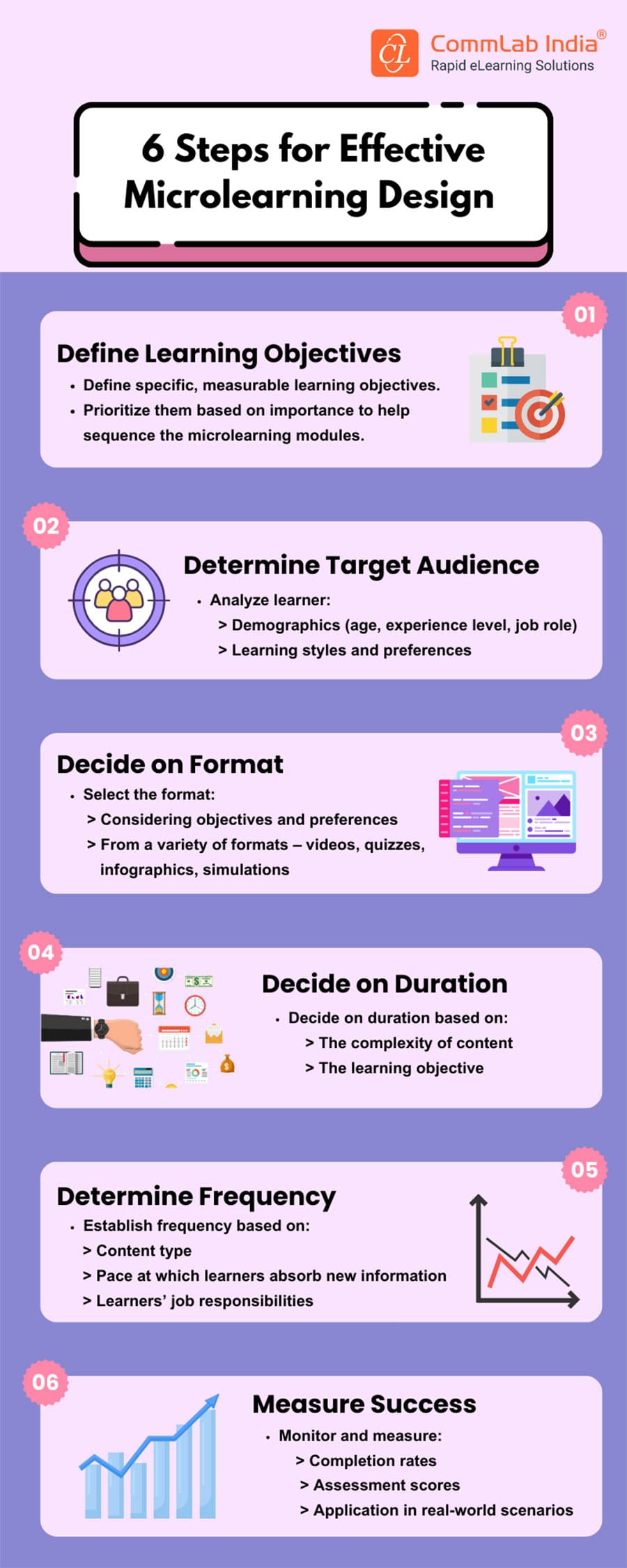How to Design Mesmerizing Microlearning Masterpieces [Infographic]
![How to Design Mesmerizing Microlearning Masterpieces [Infographic] How to Design Mesmerizing Microlearning Masterpieces [Infographic]](https://blog.commlabindia.com/hubfs/blogs/microlearning-how-to-design-info.jpg)
In today's fast-paced and highly distracting digital age, meeting the learning needs of individuals has become increasingly challenging. L&D professionals are turning to microlearning as a potential solution to address this issue. With shorter, more engaging learning modules, learners can easily engage with bite-sized content, ensuring a comprehensive learning experience despite the constraints of time and attention.
Effective design plays a crucial role in maximizing the impact of microlearning, ensuring that each module delivers meaningful learning outcomes in a concise and compelling format.
What is Microlearning?
Microlearning focuses on offering learners bite-sized relevant chunks of information to meet specific learning objectives, typically ranging from a few seconds to a few minutes in duration. It enhances both individual and organizational performance efficiently and effectively.
What are the Different Formats of Microlearning?
1.Videos
Microlearning videos delivers information quickly and visually, making complex topics easier to understand. They can include demonstrations, explanations, or interviews, providing engaging and dynamic learning experiences.
2. Quizzes
They provide immediate feedback, reinforcing learning and identifying areas for improvement. Quizzes can be in various formats such as multiple-choice, true/false, or others.
3. Infographics
Visual representations of information through infographics make complex concepts more digestible. They are a mix of text and graphics to convey key points concisely, enhancing retention and understanding.
4. Animations and GIFs
Animated visuals and GIFs add a level of interactivity and engagement to microlearning. They can illustrate concepts, or provide humorous examples, making learning more enjoyable and memorable.
5. Job Aids
Job aids help learners apply knowledge in real-world situations. They can take the form of checklists, flowcharts, or templates, providing just-in-time learning to enhance performance and productivity.
→ Download Now: Microlearning in Your Learning Strategy [eBook]
How to Design Microlearning that Grabs Attention?
Are Your Microlearning Efforts Hitting the Mark? Measuring the Effectiveness
After designing and implementing microlearning modules, it's crucial to assess their effectiveness to ensure they are meeting the desired learning outcomes. One way to measure effectiveness is through learner engagement metrics such as completion rates, time spent on each module, and user feedback. Analyzing these metrics can provide insights into the level of learner engagement and interest in the content.
Additionally, assessing knowledge retention and application is essential to gauge the impact of microlearning on performance improvement. This can be done through quizzes or assessments that test learners' understanding and ability to apply the knowledge gained from microlearning modules. By evaluating both engagement metrics and knowledge retention, organizations can determine the effectiveness of their microlearning modules and make necessary adjustments to optimize learning outcomes.
Designing Microlearning for the Win!
Microlearning courses, when designed effectively, offer a winning formula for engaging and impactful learning experiences. By breaking down complex topics into bite-sized, easily digestible nuggets of information, microlearning caters to the modern learner's short attention spans and on-the-go lifestyles. Learners can access relevant content quickly, reinforcing key concepts and skills in a way that fits seamlessly into their busy schedules.
For more insights, here’s our eBook that delves deep into the world of microlearning and unveil the secrets to creating compelling and effective microlearning experiences. Get ready to revolutionize your corporate training programs with microlearning and witness big results from small learning bites!







